Conics
Hyperbolas
Learning Objectives
By the end of this section, you will be able to:
- Graph a hyperbola with center at

- Graph a hyperbola with center at

- Identify conic sections by their equations
Before you get started, take this readiness quiz.
Graph a Hyperbola with Center at (0, 0)
The last conic section we will look at is called a hyperbola. We will see that the equation of a hyperbola looks the same as the equation of an ellipse, except it is a difference rather than a sum. While the equations of an ellipse and a hyperbola are very similar, their graphs are very different.
We define a hyperbola as all points in a plane where the difference of their distances from two fixed points is constant. Each of the fixed points is called a focus of the hyperbola.
A hyperbola is all points in a plane where the difference of their distances from two fixed points is constant. Each of the fixed points is called a focus of the hyperbola.

The line through the foci, is called the transverse axis. The two points where the transverse axis intersects the hyperbola are each a vertex of the hyperbola. The midpoint of the segment joining the foci is called the center of the hyperbola. The line perpendicular to the transverse axis that passes through the center is called the conjugate axis. Each piece of the graph is called a branch of the hyperbola.
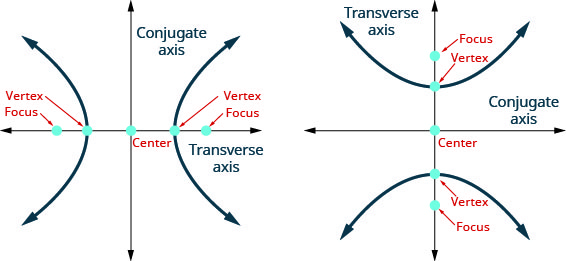
Again our goal is to connect the geometry of a conic with algebra. Placing the hyperbola on a rectangular coordinate system gives us that opportunity. In the figure, we placed the hyperbola so the foci ![]() are on the x-axis and the center is the origin.
are on the x-axis and the center is the origin.
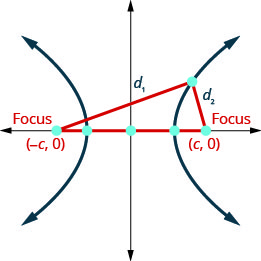
The definition states the difference of the distance from the foci to a point ![]() is constant. So
is constant. So ![]() is a constant that we will call
is a constant that we will call ![]() so
so ![]() We will use the distance formula to lead us to an algebraic formula for an ellipse.
We will use the distance formula to lead us to an algebraic formula for an ellipse.

To graph the hyperbola, it will be helpful to know about the intercepts. We will find the x-intercepts and y-intercepts using the formula.

The a, b values in the equation also help us find the asymptotes of the hyperbola. The asymptotes are intersecting straight lines that the branches of the graph approach but never intersect as the x, y values get larger and larger.
To find the asymptotes, we sketch a rectangle whose sides intersect the x-axis at the vertices ![]()
![]() and intersect the y-axis at
and intersect the y-axis at ![]()
![]() The lines containing the diagonals of this rectangle are the asymptotes of the hyperbola. The rectangle and asymptotes are not part of the hyperbola, but they help us graph the hyperbola.
The lines containing the diagonals of this rectangle are the asymptotes of the hyperbola. The rectangle and asymptotes are not part of the hyperbola, but they help us graph the hyperbola.
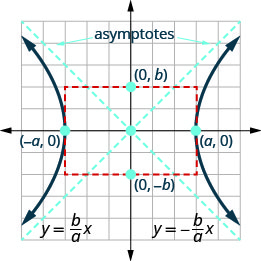
The asymptotes pass through the origin and we can evaluate their slope using the rectangle we sketched. They have equations ![]() and
and ![]()
There are two equations for hyperbolas, depending whether the transverse axis is vertical or horizontal. We can tell whether the transverse axis is horizontal by looking at the equation. When the equation is in standard form, if the x2-term is positive, the transverse axis is horizontal. When the equation is in standard form, if the y2-term is positive, the transverse axis is vertical.
The second equations could be derived similarly to what we have done. We will summarize the results here.
The standard form of the equation of a hyperbola with center ![]() is
is
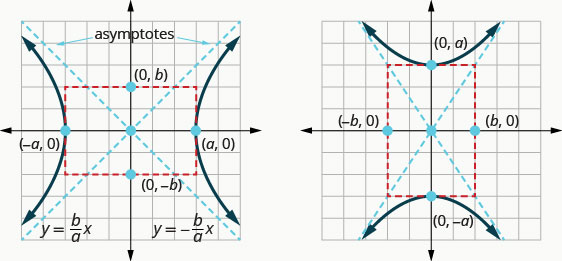
Notice that, unlike the equation of an ellipse, the denominator of ![]() is not always
is not always ![]() and the denominator of
and the denominator of ![]() is not always
is not always ![]()
Notice that when the ![]() -term is positive, the transverse axis is on the x-axis. When the
-term is positive, the transverse axis is on the x-axis. When the ![]() -term is positive, the transverse axis is on the y-axis.
-term is positive, the transverse axis is on the y-axis.
| Standard Forms of the Equation a Hyperbola with Center |
||
|---|---|---|
| Orientation | Transverse axis on the x-axis. Opens left and right |
Transverse axis on the y-axis. Opens up and down |
| Vertices | ||
| x-intercepts | none | |
| y-intercepts | none | |
| Rectangle | Use |
Use |
| asymptotes | ||
We will use these properties to graph hyperbolas.
Graph ![]()



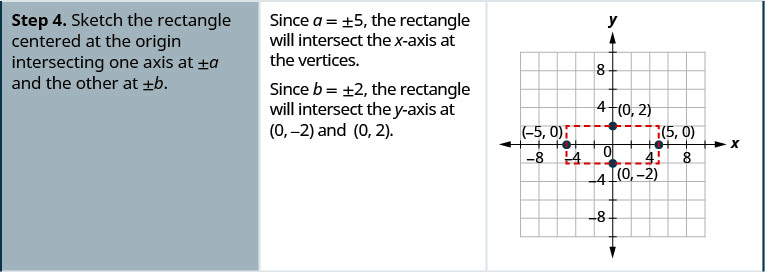
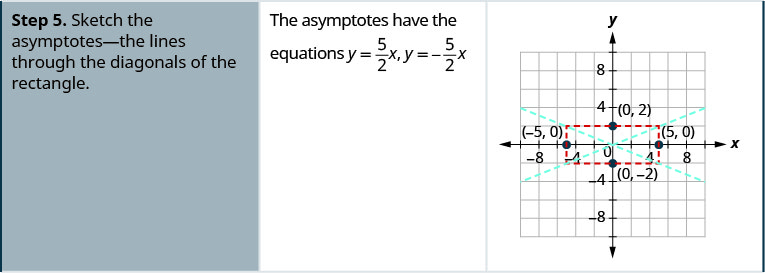
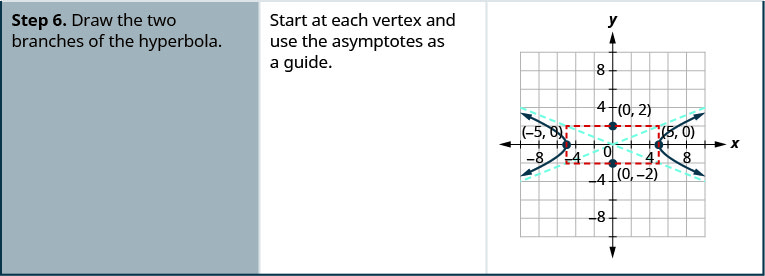
Graph ![]()
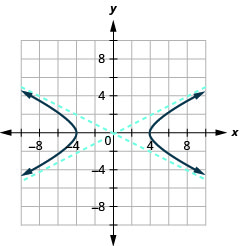
Graph ![]()
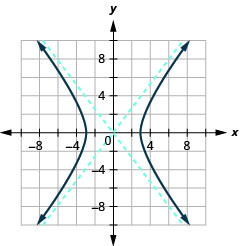
We summarize the steps for reference.
- Write the equation in standard form.
- Determine whether the transverse axis is horizontal or vertical.
- Find the vertices.
- Sketch the rectangle centered at the origin intersecting one axis at
 and the other at
and the other at 
- Sketch the asymptotes—the lines through the diagonals of the rectangle.
- Draw the two branches of the hyperbola.
Sometimes the equation for a hyperbola needs to be first placed in standard form before we graph it.
Graph ![]()
| To write the equation in standard form, divide each term by 64 to make the equation equal to 1. |
|
| Simplify. | |
| Since the y2-term is positive, the transverse axis is vertical. Since |
|
| The vertices are on the y-axis, Since |
|
| Sketch the rectangle intersecting the x-axis at Sketch the asymptotes through the diagonals of the rectangle. Draw the two branches of the hyperbola. |
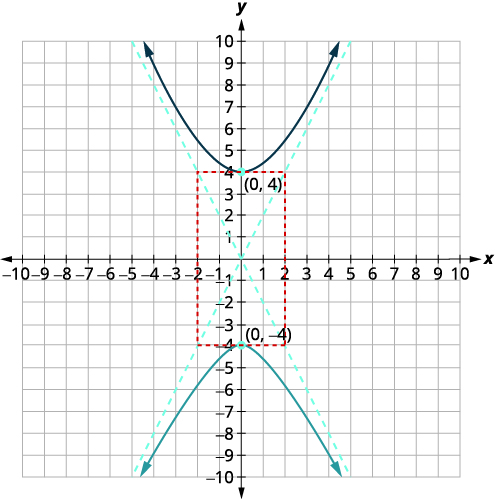 |
Graph ![]()
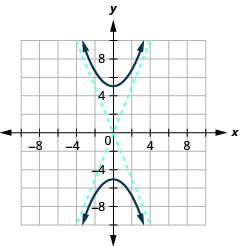
Graph ![]()
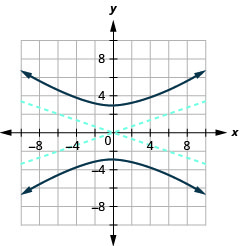
Graph a Hyperbola with Center at 
Hyperbolas are not always centered at the origin. When a hyperbola is centered at ![]() the equations changes a bit as reflected in the table.
the equations changes a bit as reflected in the table.
| Standard Forms of the Equation a Hyperbola with Center |
||
|---|---|---|
| Orientation | Transverse axis is horizontal. Opens left and right |
Transverse axis is vertical. Opens up and down |
| Center | ||
| Vertices | a units to the left and right of the center | a units above and below the center |
| Rectangle | Use a units left/right of center b units above/ below the center |
Use a units above/below the center b units left/right of center |
Graph ![]()



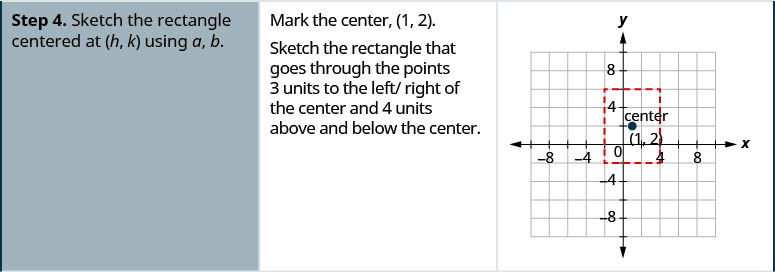
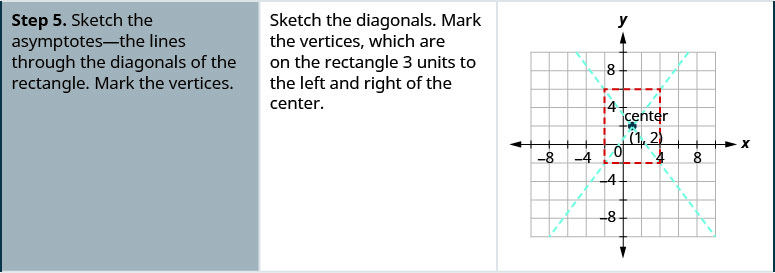
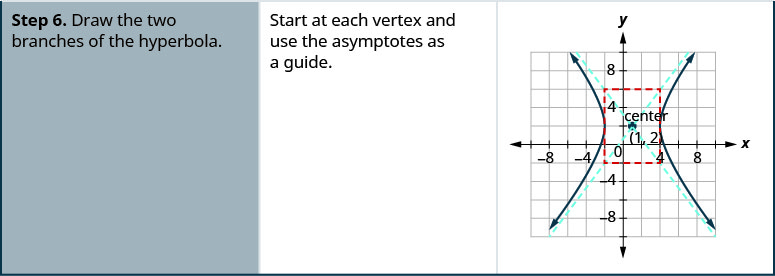
Graph ![]()
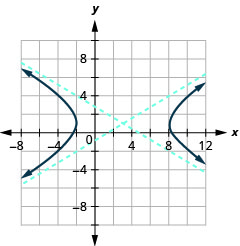
Graph ![]()
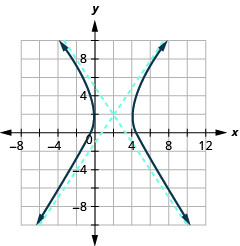
We summarize the steps for easy reference.
- Write the equation in standard form.
- Determine whether the transverse axis is horizontal or vertical.
- Find the center and a, b.
- Sketch the rectangle centered at
 using a, b.
using a, b. - Sketch the asymptotes—the lines through the diagonals of the rectangle. Mark the vertices.
- Draw the two branches of the hyperbola.
Be careful as you identify the center. The standard equation has ![]() and
and ![]() with the center as
with the center as ![]()
Graph ![]()
 |
|
| Since the opens up and down. |
 |
| Find the center, |
Center: |
| Find a, b. | |
| Sketch the rectangle that goes through the points 3 units above and below the center and 2 units to the left/right of the center. Sketch the asymptotes—the lines through the diagonals of the rectangle. Mark the vertices. Graph the branches. |
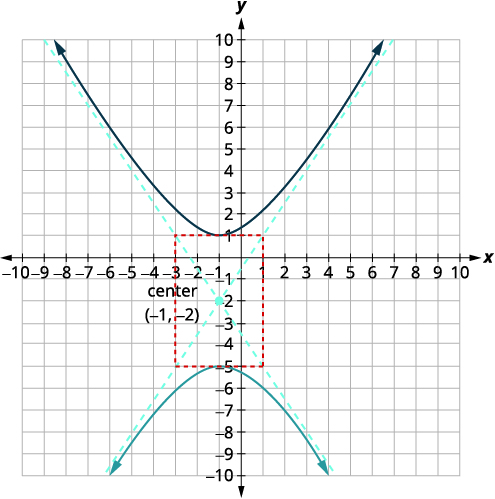 |
Graph ![]()
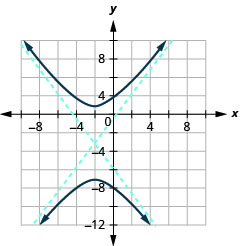
Graph ![]()
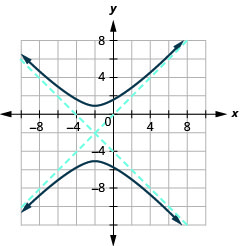
Again, sometimes we have to put the equation in standard form as our first step.
Write the equation in standard form and graph ![]()
 |
|
| To get to standard form, complete the squares. |  |
 |
|
 |
|
| Divide each term by 36 to get the constant to be 1. |  |
 |
|
| Since the opens left and right. |
|
| Find the center, |
Center: |
| Find a, b. | |
| Sketch the rectangle that goes through the points 3 units to the left/right of the center and 2 units above and below the center. Sketch the asymptotes—the lines through the diagonals of the rectangle. Mark the vertices. Graph the branches. |
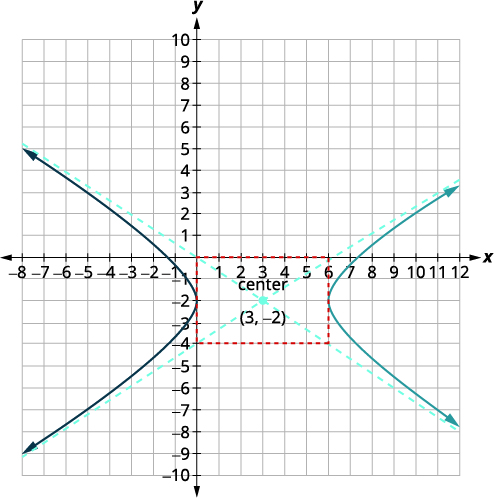 |
ⓐ Write the equation in standard form and ⓑ graph ![]()
ⓐ![]()
ⓑ
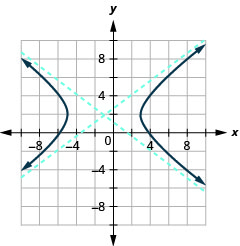
ⓐ Write the equation in standard form and ⓑ graph ![]()
ⓐ![]()
ⓑ
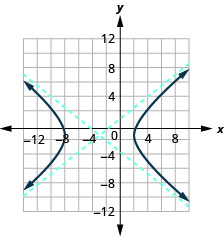
Identify Conic Sections by their Equations
Now that we have completed our study of the conic sections, we will take a look at the different equations and recognize some ways to identify a conic by its equation. When we are given an equation to graph, it is helpful to identify the conic so we know what next steps to take.
To identify a conic from its equation, it is easier if we put the variable terms on one side of the equation and the constants on the other.
| Conic | Characteristics of |
Example |
|---|---|---|
| Parabola | Either |
|
| Circle | ||
| Ellipse | ||
| Hyperbola |
Identify the graph of each equation as a circle, parabola, ellipse, or hyperbola.
ⓐ![]()
ⓑ![]()
ⓒ![]()
ⓓ![]()
ⓐ
ⓑ
ⓒ![]()
ⓓ![]()
Identify the graph of each equation as a circle, parabola, ellipse, or hyperbola.
ⓐ![]()
ⓑ![]()
ⓒ![]()
ⓓ![]()
ⓐ circle ⓑ ellipse ⓒ parabola ⓓ hyperbola
Identify the graph of each equation as a circle, parabola, ellipse, or hyperbola.
ⓐ![]()
ⓑ![]()
ⓒ![]()
ⓓ![]()
ⓐ ellipse ⓑ parabola ⓒ circle ⓓ hyperbola
Access these online resources for additional instructions and practice with hyperbolas.
Key Concepts
- Hyperbola: A hyperbola is all points in a plane where the difference of their distances from two fixed points is constant.

Each of the fixed points is called a focus of the hyperbola.
The line through the foci, is called the transverse axis.
The two points where the transverse axis intersects the hyperbola are each a vertex of the hyperbola.
The midpoint of the segment joining the foci is called the center of the hyperbola.
The line perpendicular to the transverse axis that passes through the center is called the conjugate axis.
Each piece of the graph is called a branch of the hyperbola.
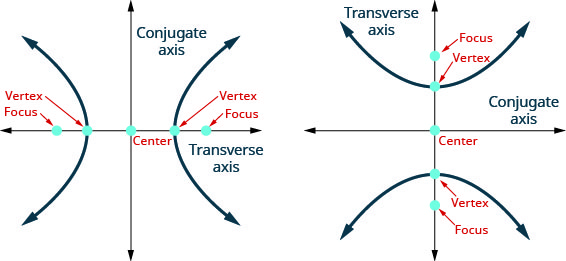
Standard Forms of the Equation a Hyperbola with Center 


Orientation Transverse axis on the x-axis.
Opens left and rightTransverse axis on the y-axis.
Opens up and downVertices 



x-intercepts 

none y-intercepts none  ,
, 
Rectangle Use 

Use 

asymptotes 



- How to graph a hyperbola centered at

- Write the equation in standard form.
- Determine whether the transverse axis is horizontal or vertical.
- Find the vertices.
- Sketch the rectangle centered at the origin intersecting one axis at
 and the other at
and the other at 
- Sketch the asymptotes—the lines through the diagonals of the rectangle.
- Draw the two branches of the hyperbola.
Standard Forms of the Equation a Hyperbola with Center 


Orientation Transverse axis is horizontal.
Opens left and rightTransverse axis is vertical.
Opens up and downCenter 

Vertices a units to the left and right of the center a units above and below the center Rectangle Use a units left/right of center
b units above/below the centerUse a units above/below the center
b units left/right of center - How to graph a hyperbola centered at

- Write the equation in standard form.
- Determine whether the transverse axis is horizontal or vertical.
- Find the center and

- Sketch the rectangle centered at
 using
using 
- Sketch the asymptotes—the lines through the diagonals of the rectangle. Mark the vertices.
- Draw the two branches of the hyperbola.
Conic Characteristics of  and
and  terms
termsExample Parabola Either  OR
OR  Only one variable is squared.
Only one variable is squared.
Circle  and
and  terms have the same coefficients
terms have the same coefficients
Ellipse  and
and  terms have the same sign, different coefficients
terms have the same sign, different coefficients
Hyperbola  and
and  terms have different signs, different coefficients
terms have different signs, different coefficients
Practice Makes Perfect
Graph a Hyperbola with Center at ![]()
In the following exercises, graph.
![]()
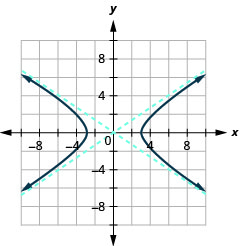
![]()
![]()
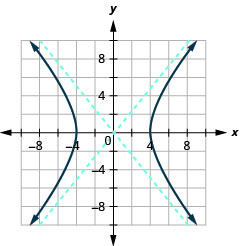
![]()
![]()
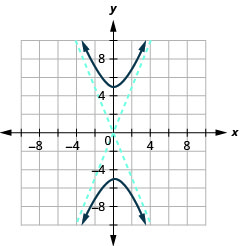
![]()
![]()
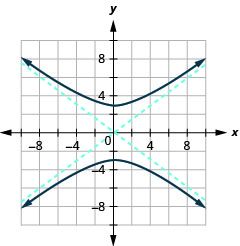
![]()
![]()
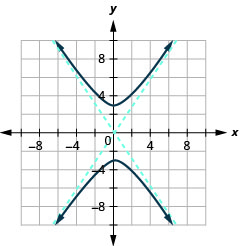
![]()
![]()
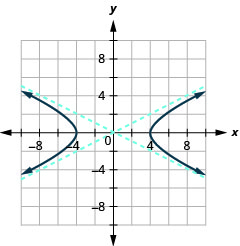
![]()
Graph a Hyperbola with Center at ![]()
In the following exercises, graph.
![]()
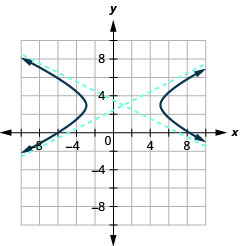
![]()
![]()
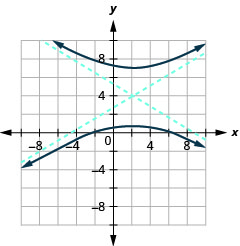
![]()
![]()
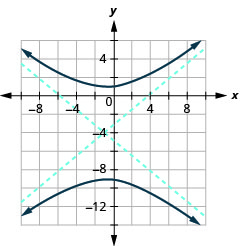
![]()
![]()
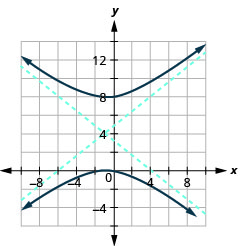
![]()
![]()
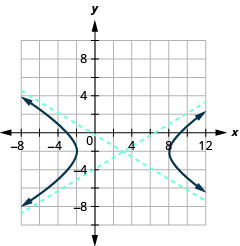
![]()
In the following exercises, ⓐ write the equation in standard form and ⓑ graph.
![]()
ⓐ![]()
ⓑ
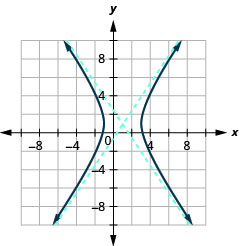
![]()
![]()
ⓐ![]()
ⓑ
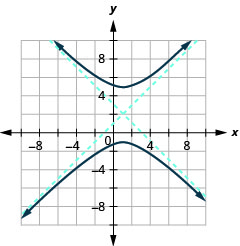
![]()
![]()
ⓐ![]()
ⓑ
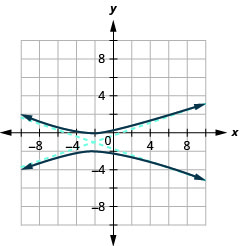
Identify the Graph of each Equation as a Circle, Parabola, Ellipse, or Hyperbola
In the following exercises, identify the type of graph.
ⓐ![]()
ⓑ![]()
ⓒ![]()
ⓓ![]()
ⓐ![]()
ⓑ![]()
ⓒ![]()
ⓓ![]()
ⓐ parabola ⓑ circle ⓒ hyperbola ⓓ ellipse
Mixed Practice
In the following exercises, graph each equation.
![]()
![]()
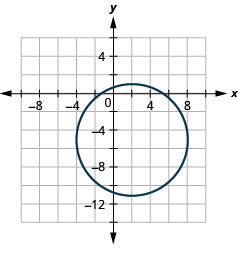
![]()
![]()
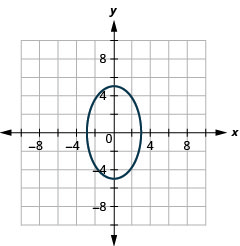
![]()
![]()
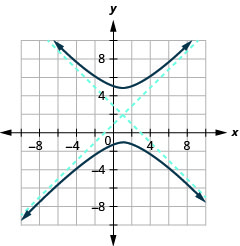
![]()
![]()
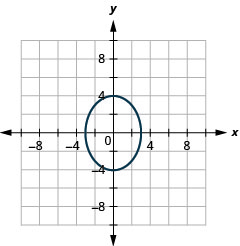
Writing Exercises
In your own words, define a hyperbola and write the equation of a hyperbola centered at the origin in standard form. Draw a sketch of the hyperbola labeling the center, vertices, and asymptotes.
Explain in your own words how to create and use the rectangle that helps graph a hyperbola.
Answers will vary.
Compare and contrast the graphs of the equations ![]() and
and ![]()
Explain in your own words, how to distinguish the equation of an ellipse with the equation of a hyperbola.
Answers will vary.
Self Check
ⓐ After completing the exercises, use this checklist to evaluate your mastery of the objectives of this section.

ⓑ On a scale of 1-10, how would you rate your mastery of this section in light of your responses on the checklist? How can you improve this?
Glossary
- hyperbola
- A hyperbola is defined as all points in a plane where the difference of their distances from two fixed points is constant.

